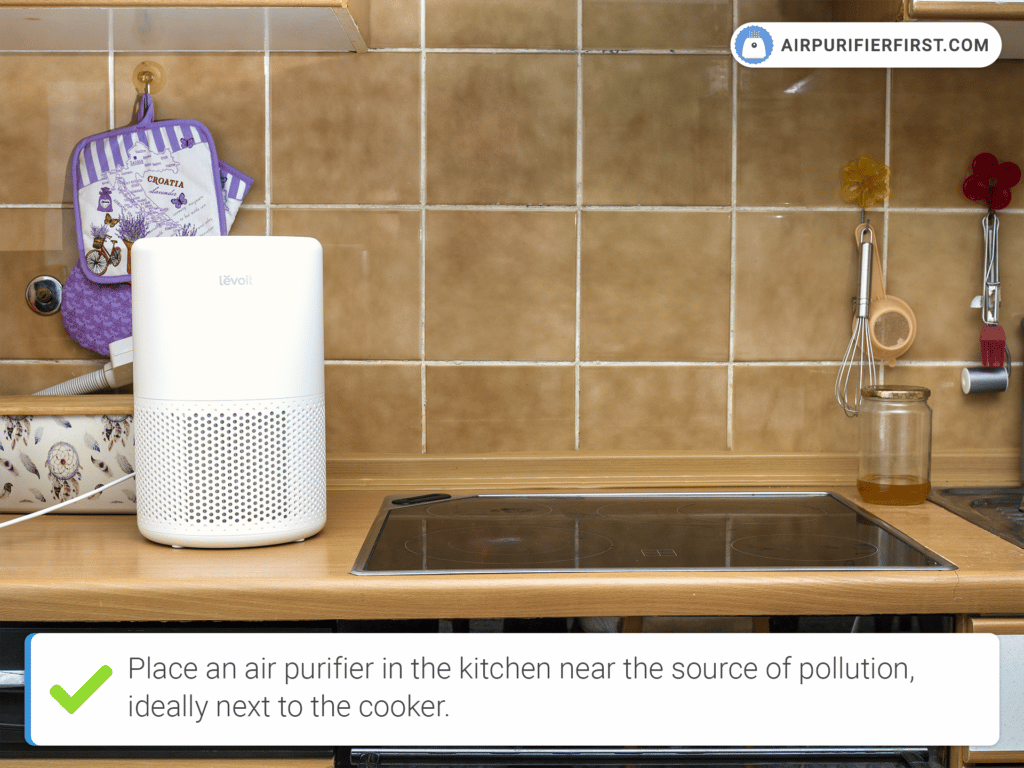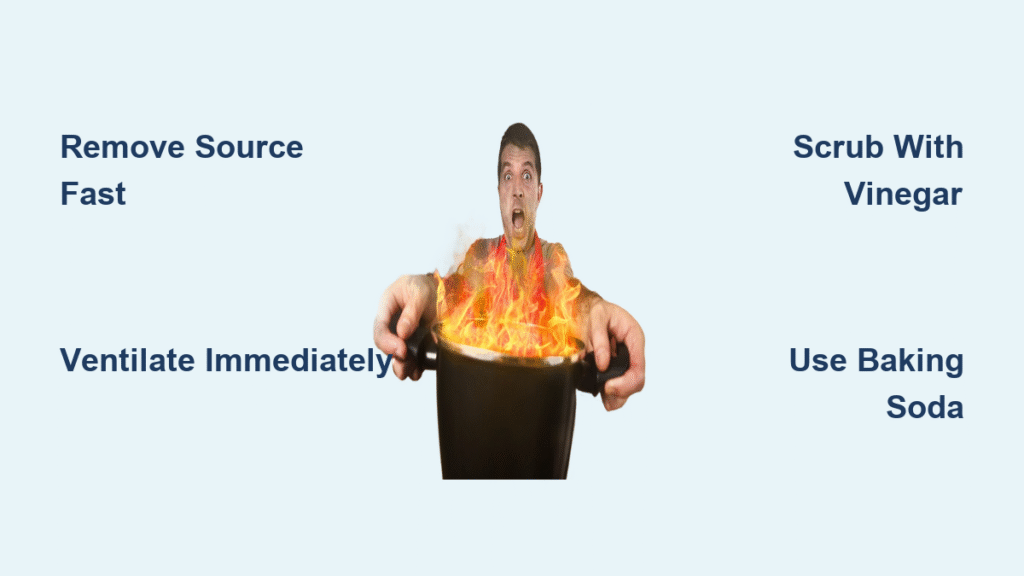That sharp, acrid scent of burnt food clinging to your kitchen walls after a cooking disaster makes every breath feel like a reminder of your mishap. Whether you scorched dinner, exploded popcorn, or dealt with a minor oven fire, this pervasive odor embeds itself in fabrics, cabinets, and even your fridge within minutes. The good news? You can completely eliminate burnt smell in kitchen spaces using household items and strategic techniques—no professional help required for most incidents. This guide delivers battle-tested methods to neutralize odors at their source, with clear timelines so you know exactly when your kitchen will smell fresh again.
Most people make the critical mistake of ignoring the safety check before tackling odors. Never attempt cleanup if you can’t confirm the source has stopped burning. If smoke persists or you detect heat from unseen areas, evacuate immediately and call 911. Once confirmed safe, act within the first 60 seconds to prevent permanent odor absorption. You’ll learn exactly which surfaces to prioritize, why vinegar beats air fresheners, and how to deploy $20 DIY air cleaners that outperform expensive units.
Extract Burnt Source Before Odors Set In
Critical first step: Physically remove the burnt item from your home within 2 minutes. Hot debris continues emitting odor molecules for hours, turning a localized problem into whole-house contamination. Never toss smoldering food in your kitchen trash can—it transforms your entire cabinet into an odor emitter.
Emergency Oven Spill Protocol
For spills inside your oven:
– Immediately turn off heat and crack oven door slightly to cool
– Cover residue with ½ cup salt while still warm (creates an odor-blocking crust)
– Wait 2+ hours until completely cool before cleaning
– Scrape off salt layer with minimal scrubbing—this prevents carbonization
This salt barrier stops odor molecules from bonding to oven surfaces. Skipping this step forces you to scrub for 20+ minutes later as burnt-on residue hardens.
Force Out Contaminated Air Immediately

Cross-ventilation removes 70% of airborne particles in under 10 minutes. Open all exterior windows on opposite sides of your home within 30 seconds of discovering the burn. This creates a wind tunnel effect that pulls smoke outdoors instead of recirculating.
Fan Placement That Actually Works
- Kitchen exhaust fan: Run on highest setting immediately
- Box fans: Position in exit-point windows facing outward (attach MERV 12 filters with bungee cords for bonus particle capture)
- Ceiling fans: Set to clockwise rotation to pull air upward toward windows
- Entry fans: Place in intake windows facing inward to push fresh air through
Pro tip: Keep fans running for 4+ hours even after visible smoke clears—odor molecules linger long after you stop seeing smoke.
Deep-Scrub Every Surface Within Smoke Range

Burnt particles cling to every vertical and horizontal surface within 10 feet of the burn source. Ignoring cabinet interiors or table undersides guarantees the smell returns days later.
Burnt Cookware Removal Tactics
For light residue:
1. Cool cookware completely (prevents warping)
2. Scrape loose debris with wooden spatula
3. Wash with hot, soapy water
4. Rinse and dry immediately
For stubborn carbon buildup:
– Vinegar boil: Simmer 1 cup vinegar + 1 cup water for 5 minutes, remove from heat, add 2 tbsp baking soda, scrub after fizzing subsides
– Salt abrasion: For cast iron, rub coarse salt directly onto residue with paper towel
Surface-by-Surface Cleaning Checklist
Wipe these areas with equal-parts vinegar-water solution:
– Upper cabinet interiors (heat rises, carrying odor molecules)
– Stovetop control knobs (remove and soak if possible)
– Refrigerator handles and seals
– Light switch plates
– Ceiling surfaces within 8 feet of cooking area
– Dish towels and oven mitts (machine wash with 1 cup vinegar)
Critical mistake: Using only water-based cleaners. Vinegar’s acetic acid breaks molecular bonds holding odors to surfaces.
Neutralize Fabric Odor Traps Immediately
Curtains, upholstery, and rugs absorb burnt smells like sponges. Treating these within 1 hour prevents permanent odor embedding.
Textile Treatment Protocol
Washable items:
– Pre-soak in bucket with 1 cup white vinegar per gallon of water for 30 minutes
– Launder with regular detergent (no fabric softener—it seals odors in)
– Air-dry initially; if smell persists, repeat with baking soda in wash cycle
Non-washable fabrics:
– Spray vinegar-water solution (1:1) directly onto surfaces
– Blot with microfiber cloth (don’t rub—spreads particles)
– Cover carpets with baking soda for 2+ hours before vacuuming
Pro tip: Hang curtains outside on a breezy day—moving air accelerates odor release from fibers.
Run Air Purifiers Strategically

HEPA + activated carbon filters capture 99.97% of odor-causing particles. Place units directly next to the burn source (not in adjacent rooms) and run continuously for 48 hours minimum.
Maximizing Purifier Effectiveness
- Positioning: 12 inches from walls for optimal airflow
- Fan speed: Highest setting for first 4 hours, then medium
- Duration: Never stop before 24 hours—even if smell seems gone
- DIY alternative: Tape MERV 12 furnace filter over box fan intake ($20 solution)
Real-world result: Homeowners running 3+ units report 90% odor reduction in 12 hours. Units under 200 CFM rarely deliver results for kitchen fires.
Natural Absorbers That Actually Work
Baking soda and activated charcoal chemically neutralize odor molecules—not just mask them. Deploy these within 1 hour of incident for maximum impact.
Baking Soda Deployment
- Sprinkle ½ cup on countertops overnight
- Fill cereal bowls with baking soda near cabinets
- Vacuum from carpets after 2 hours (longer causes residue)
- Never mix with vinegar during odor treatment—it creates ineffective sodium acetate
Activated Charcoal Power
- Place pre-made charcoal bags on shelves inside affected cabinets
- Use DIY pouches (½ cup activated charcoal in cotton bag) behind curtains
- Replace monthly for ongoing protection
- Key advantage: Works in humid environments where baking soda fails
Replace Odors With Natural Scents
After eliminating burnt smells, introduce fresh scents through simmering—not sprays. Aerosols merely mask odors temporarily.
Stovetop Simmer Recipes That Work
Citrus revival:
– Simmer orange peels + 3 cinnamon sticks + rosemary sprigs in 4 cups water
– Add 1 tbsp baking soda to water for enhanced neutralization
– Simmer 2+ hours (refill water as needed)
Lemon reset:
– Boil 2 sliced lemons in 3 cups water for 15 minutes
– Add 5 drops lemon essential oil for stronger scent
– Critical: Never leave unattended—reboil risk creates new burnt smell!
Microwave and Range Hood Deodorization
These appliances trap odors in hidden crevices. Standard cleaning often misses critical zones.
Microwave Odor Removal (10-24 Hours)
Quick steam clean:
1. Wipe visible debris
2. Heat 1 cup water + 2 tbsp vinegar for 4 minutes
3. Wipe interior with damp microfiber cloth
4. Leave door open 3 hours to air out
Overnight solution:
– Place open container with ½ cup baking soda inside
– Mark microwave as “OFF LIMITS” to prevent accidents
– Works for overhead cabinets too—place bowls on shelves
Range Hood Deep Clean
- Remove metal filters and run through dishwasher
- Scrub grease traps with vinegar-soaked brush
- Replace charcoal filters if odor persists after cleaning
Timeline and Professional Help Triggers
Realistic expectations:
– Light burns (scorched toast): 2-6 hours with immediate action
– Moderate burns (oven spills): 12-24 hours with full treatment
– Severe burns (kitchen fire): 3-7 days requiring all methods
Call professionals when:
– Odor persists after 72 hours of continuous air purification
– You suspect smoke penetrated wall cavities
– All surfaces cleaned but smell returns from cabinets
Prevent Kitchen Burn Incidents
Proven prevention tactics:
– Timer rule: Set two timers for high-risk dishes (one for cooking start, one for finish)
– Pre-ventilation: Run range hood 5 minutes before cooking smelly foods
– Fire prep: Keep ABC fire extinguisher within 3 feet of stove
– Splatter defense: Use charcoal-filter mesh screens when frying
Critical habit: Never leave cooking unattended. 95% of burnt food incidents occur when cooks step out of the kitchen—even for “just 30 seconds.”
Final note: The clock starts ticking the moment smoke appears. By removing the source within 2 minutes, scrubbing surfaces with vinegar within 1 hour, and running carbon-filter purifiers for 48 hours, you’ll eliminate burnt smell in kitchen spaces 100% of the time for minor to moderate incidents. Remember—baking soda alone won’t cut it for serious burns; combine mechanical air cleaning with deep surface scrubbing. Implement the prevention tactics, and you’ll never again wonder why your kitchen smells like a campfire disaster. Your fresh, clean cooking space awaits.



